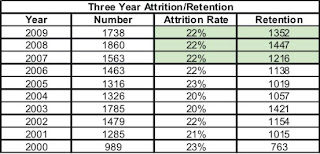In this note we are most interested in a singularly important aspect of American education, that of our corps of mathematics teachers. We look at numbers. Included in this report are the numbers of new teachers and the all important retention/attrition rates.
Teacher Certification – New Teachers
As reported by the Texas State Board for Educator Certification, we consider numbers of candidates who received initial Mathematics and Science certifications over the ten fiscal years, 2000-2009. Important conclusions are
- Mathematics teachers remained predominantly female and white in all the years under consideration, despite substantial year-by-year changes.
- About 70% of all newly certified math teachers are female correspondingly 30% are male.
- By ethnicity, the data reports that 8.76% are African American, 68.33% are white, 16.48% are Hispanic, 5.10% are Asian, 1.05% are Native American, and 2.12% are Other.
- The percentage of white Mathematics teachers declined precipitously by more than 10% over this period, while the percentage of Hispanic teachers increased slightly, by about 4%.
- African American percentage was relatively flat over this period, while the percentage of Asian teachers grew from a low of 2% to currently about 5%.
The actual male-female data is shown in the chart below.
As a graphic we illustrate the growth of math teachers over the period under consideration.
The linear regression lines reveal that the numbers of newly certified teachers is rising by about 62 new teachers each year. Yet, currently this meets only about 50% of the demand.
Retention
Reliable retention data is difficult to find and interpret. However, a recent report issued by the Sid Richardson Foundation [1] gives a detailed study based on 51 science and math teachers over the past few years. In this note, however, we use data as reported by Fuller [2]. The shaded region is projected.
As reported, the attrition rate for Alternatively Certified (ACP) Teachers is fully 14 percentage points higher than for the traditional certification process. Could this be accounted for by the facts that (1) Entering the teaching profession is often a lofty and idealistic goal, and (2) When the idealism does not pan out, ACP teachers have an alternate profession to fall back upon. This is a counter explanation to the other oft cited reason that the traditional method better prepares teachers for the duration. The Richardson
As a final note, fully 14,25% of high school math teachers are teaching out of field. This percentage is about half again higher for economically disadvantaged school districts. Since, in 2008, only 61% of the demand for teachers was met by the supply of teachers, it is little wonder at the high attrition rates and out-of-field teaching assignments. The demand percentage continues to drop, and is projected at about 50% for 2012.
References
1. 51 Math and Science Teachers in Texas
Sid W. Richardson Foundation Forum, January 2012, www.sidrichardson.org/51teachers
2. Fuller, E. J. (2008, October). Secondary mathematics and science teachers in Texas Austin , TX : Texas Instruments, Inc. and Texas



Comments
Post a Comment
Please Comment.